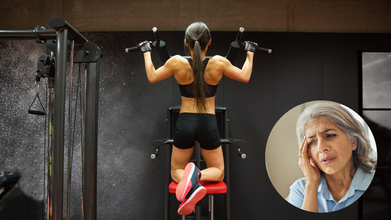- Health Conditions A-Z
- Health & Wellness
- Nutrition
- Fitness
- Health News
- Ayurveda
- Videos
- Medicine A-Z
- Parenting
- Web Stories
Prison Workout Is One Of The Deadliest Workouts You Can Do And It Doesn't Need A Single Equipment

Credit: Canva
You must wonder, without proper equipment and weights, how would a prison workout help you gain muscles? It is because this type of workout includes high training frequency, meaning that there are repeating exercises multiple times a week. Besides, it performs high repetitions to induce muscle hypertrophy. Moreover, people in most prisons, particularly in the West, get three meals plus the option to buy food. This enables them to consume enough calories to support muscle recovery and growth.
Even though the pandemic lockdowns are long behind us, there are still moments when a gym session isn't an option—whether due to a packed travel schedule, lack of access to fitness equipment, or time constraints. So what do you do? How do you keep fit? Well, in these cases, drawing inspiration from high-intensity, space-efficient workouts can be the perfect solution to maintaining fitness on the go.
One such method is the prison workout, a regimen popularized by individuals who had limited access to weights but still managed to build significant strength. These routines focus on bodyweight exercises and can be done in confined spaces, making them ideal for anyone looking to stay fit without a gym.
What Exercises Make Up Prison Workout?
Prison workouts are high-intensity, bodyweight-focused exercises that require little to no equipment. They incorporate movements such as squats, lunges, push-ups, pull-ups, dips, sit-ups, and hanging leg raises.
These exercises emphasize progressive overload—gradually increasing intensity to build muscle and strength. High repetition schemes promote hypertrophy (muscle growth), while plyometric movements enhance cardiovascular endurance.
How To Structure A Prison Workout?
Structuring a Prison-Style Workout Routine
Due to their accessibility and efficiency, these workouts can be structured in multiple ways. Some common approaches include:
4-Day Split Routine: This routine prompts you to focus on your upper body on day 1, followed by lower body on day 2, and a full-body workout on day 3. Then, on the fourth day, you rest.
Alternatively, a push-pull-lower split can be followed.
Day 1: Push (chest, triceps, shoulders)
Day 2: Pull (back, biceps)
Day 3: Lower body
Day 4: Push
Day 5: Pull
Day 6: Lower body
Day 7: Rest
You Can Also Opt For Jailhouse Strong Method
A well-known variation of prison workouts is the Jailhouse Strong method. This approach follows a descending rep structure, similar to a reverse pyramid system. It puts maximum rep for any exercise in the first day, while simultaneously descending in the subsequent days. For example, a squat routine could start by performing 20 reps and then start descending by one less rep every day. This way, a person following a jailhouse strong method could follow 19 squats and then 18 and so on. Notably, between each set, walking a short distance before resuming can help maintain movement while ensuring muscle recovery.
Prison Workout: What Role Nutrition Plays
For those looking to gain muscle, following a structured nutrition plan is key:- Eat balanced meals with adequate protein, carbohydrates, and healthy fats.
- Maintain a calorie surplus (200-400 extra calories per day) to support muscle building.
- Consume sufficient protein (1.6–2g per kg of body weight) to aid muscle repair and growth.
- Prioritize recovery with adequate sleep and rest days.
Long Walks Vs Several Short Walks? Study Reveals Which One Is Better For Your Health

(Credit-Canva)
Walking is said to be one of the best exercises. Not only is it an easy and accessible exercise, but it can be done anywhere and also does not need a lot of equipment. Many people aim for 10,000 steps a day as a sign of good health. But should you take one long walk, or multiple short ones? A new study has answered this question.
New research suggests that a single, longer walk each day is better for your heart than breaking up your steps into many short strolls, especially if you don't exercise regularly.
The study, published in Annals of Internal Medicine, found that walking for at least 15 minutes without stopping is ideal. This longer, steady pace, which is about 1,500 continuous steps gives your heart a much better workout.
Longer Vs Shorter Walks: Which is Better?
Researchers tracked the walking habits of over 33,500 adults in the UK who walked less than 8,000 steps a day. After tracking their health for eight years, the findings were clear:
Lower Heart Risk
People who consistently walked in longer, uninterrupted stretches had a lower risk of heart problems compared to those who only took short, quick bursts of steps.
Why Are Longer Walks Better For Health?
Even among the least active group (those walking under 5,000 steps daily), taking longer walks made a major difference. Their risk of heart disease and early death dropped significantly.
The researchers explain that most people focus only on the number of steps they take, but not the patterns. They suggests that even inactive people can boost heart health by changing their habits to walk for at least 10–15 minutes at a time.
Should People Focus More On How They Walk Or How Much?
Many people aim for 10,000 steps a day, but that number actually came from an old pedometer advertisement, not science. While experts agree more steps are generally good, this study emphasizes that how you walk matters more than just the total step count.
The researchers suggest that simple changes, like setting aside time specifically for a long walk, could make a big impact on heart health.
The NHS still recommends getting 150 minutes of moderate activity like brisk walking, each week, and ideally it should be spread out. For older adults, moving every day, even with light activity around the house, is key.
It's important to know that while the study shows a strong link between longer walks and better health, it doesn't definitively prove that walking directly causes the improvement.
However, health experts agree exercise is vital. They explain that you might find it hard at first, but it will get easier as your body adjusts. Even small improvements contribute to a healthy heart.
What Are Some Safety Tips for Walkers?
While walking is generally a safe activity, accidents can happen, especially if you like to walk alone. To stay safe while walking,
Be Visible
Wear bright, reflective clothing or carry a flashlight after dark or in dim light so drivers and others can easily spot you.
Stay Alert
Focus on your immediate surroundings; avoid distractions like your phone or headphones to always know what's happening around you, especially traffic.
Use Paths
Walk or bike only on marked paths, lanes, or sidewalks, and cross streets at designated crosswalks where vehicles are expecting pedestrians.
This Simple Grip Test Could Predict Your Dementia Risk

Credits: Canva
Dr Peter Attia, physician, and researcher known for his work in longevity medicine believes that there is a correlation between your grip strength and dementia onset risk and dementia mortality.
Dr Attia says, "My best explanation for this is that grip strength is itself a proxy for overall strength. The type of strength we are talking about here is acquired, not inherited. You had to do a bunch of work to get it, and it is the work you did that is actually what's protect your brain."
He says that women who are over 40, must be able to hand on a bar for a minute and a half, and for men, it is two minutes. The key is that you are supposed to be able to carry 75% of your weight, he says, in an interview with CBS News' 60 minutes.
Is There Any Truth In The Claim That Grip Strength Has A Correlation With Dementia?
As per a 2021 study published in journal Frontiers in Aging Neuroscience, titled Grip Strength and the Risk of Cognitive Decline and Dementia: A Systematic Review and Meta-Analysis of Longitudinal Cohort Studies, loss of grip strength and cognitive impairment are prevalent in the elderly, and they may share the pathogenesis in common.
The study found that poorer grip strength was in fact associated with more risk of cognitive decline and dementia. The subgroup analysis within the study also indicated that people with poorer strength had more risk of Alzheimer's disease and non-AD dementia.
But why does this happen? Lower grip strength is a marker for overall muscle mass, general health, and is linked to the health of the brain and its blood vessels. This link is also connected to other factors like vascular health, cognitive decline, and physical activity, as low grip strength can be a symptom of poor overall physical and metabolic health.
How Is Lower Grip Strength Is Linked To Dementia?
Indicator Of Overall Health: Grip strength reflects the health of entire body, this is why a lower grip strength is an indicate of lower muscle mass, and general poor health.
Vascular and brain health: Since there is a connection between muscle strength, blood flow, and brain health, thus lower grip strength is associated with a higher risk of vascular dementia and a greater volume of white matter hyperintensities in the brain.
Also Read: What Home Gym Tools Can Help You Stay Fit Without Hitting The Gym?
Poorer grip strength is associated with lower cognitive function, such as fluid intelligence and prospective memory. This suggest a link between the body's physical capabilities and the brain's cognitive abilities.
A different study published in 2022, where 40,000 participants from the UK Biobank were studied found that greater grip strength was associated with better cognitive functioning, higher life satisfaction, greater subjective well-being, and reduced depression and anxiety symptoms while controlling for numerous demographic, anthropometric, and socioeconomic cofounders.
The study also found that grey matter volume of subcortical region also correlated with better mental health and considerably mediated their relationship with grip strength.
One Long Walk Over Few Short Strolls Could Keep Your Heart Healthy

Credits: Canva
A new study published in the Annals of Internal Medicine suggests that you should choose one long walk over a few short strolls to keep your heart healthy. This is especially if you do not exercise much.
Walking for at least 15 minutes without a stop is ideal, notes the study. This means you walk for 1,500 steps in a row. This is said to give your heart a good workout. The study also notes that many people who walk 10,000 steps a day, actually follow the number that came from a Japanese pedometer advertisement, and not necessarily science, also reported by BBC. However, experts do agree that more steps are generally better for your health.
How Was The Study Conducted?
The study analyzed 33,560 adults who were aged 40 to 79 in the UK. They walked fewer than 8,000 steps a day. These people were grouped by how long their walks were and was measured with a step-counter over a week:
- Less than 5 minutes (43%)
- 5 to 10 minutes (33.5%)
- 10 to 15 minutes (15.5%)
- 15 minutes or more (8%)
The data was collected after tracking the participants for eight years. This was done by the researchers from the University of Sydney and the Universidad Europea in Spain.
What Did The Study Find?
The study found that people who walked in longer stretches had a lower risk of heart problems than those who take short strolls. Even those who are the least active, for instance, those who walk under 5,000 steps a day, longer walks make a big difference for them. The study noted that for them too, the risk of heart disease and death drop significantly.
However, the study cannot guarantee that this change is because they were already fitter to begin with. However, the researchers did study this factor including whether the person smoked, was obese or had high cholesterol.
How You Walk Matters More Than How Much You Walk
The researchers also noted that the way you walk could actually matter more than how much you walk. The answer is walk for a longer time, even if you do not walk that much overall. You could implement simple changes, including setting some time aside for a longer walk.
The Co-lead research Prom Emmanuel Stamatakis said, "We tend to place all the emphasis on the number of steps or the total amount of walking but neglect the crucial role of patterns, for example 'how' walking is done. This study shows that even people who are very physically inactive can maximise their heart health benefit by tweaking their walking patterns to walk for longer at a time, ideally for at least 10-15 minutes, when possible."
The National Health Service, UK, also recommends 150 minutes of moderate activity per week. This could be brisk walking, which could be spread out across the week. Older adults, especially those who are over 65, are recommended to try to move a little more every day, even if it is to do some household activities.
A senior cardiac nurse at the British Heart Foundation, Emily McGrath told BBS, "Exercise helps everyone live a happier and healthier life. If you have heart and circulatory disease, it can help you manage your condition and make you feel better overall. You may find it hard to be more active at first, but as time goes on it'll get easier as your body gets used to the activity. You may only notice small improvements at first, but it all adds up and counts towards keeping your heart healthy."
© 2024 Bennett, Coleman & Company Limited

